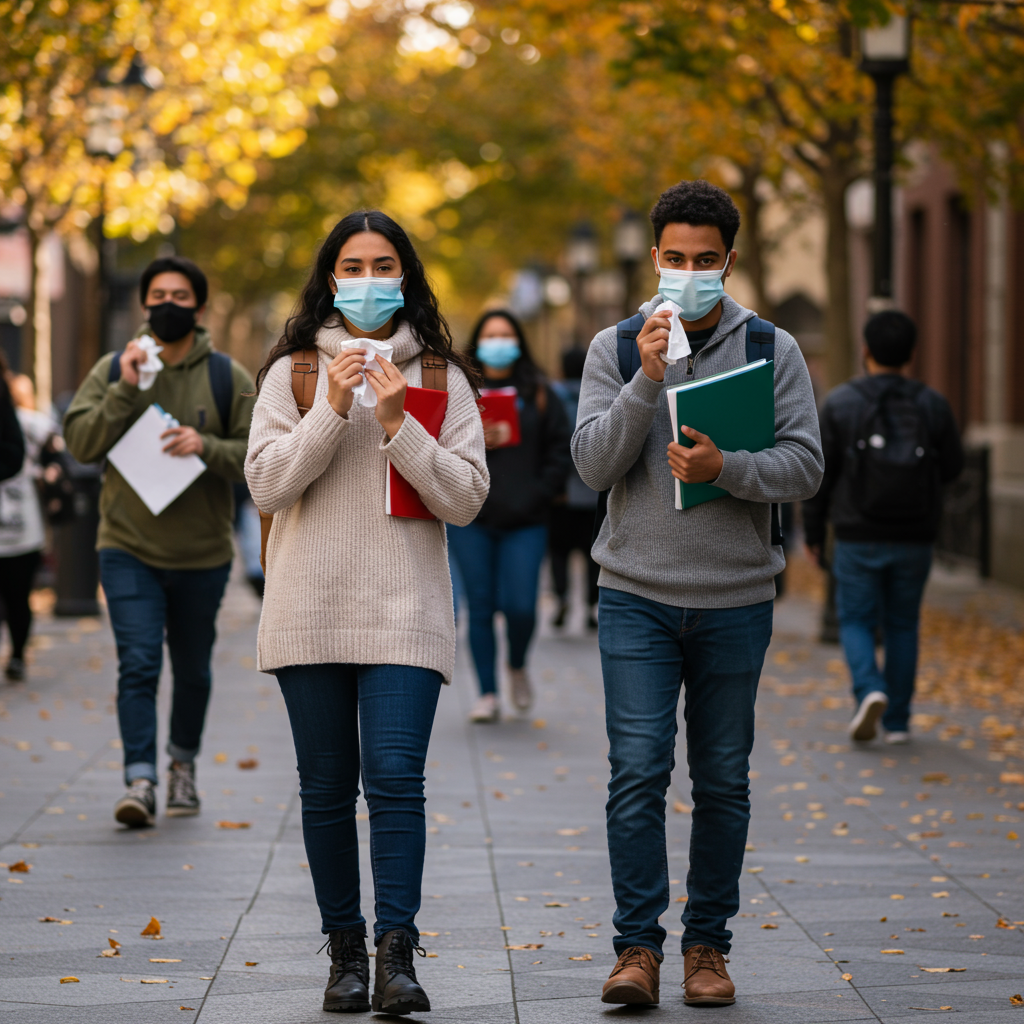As autumn arrives, bringing vibrant leaves and cozy evenings, it also signals the inevitable return of cold and flu season. For post-secondary students, this period often means navigating a higher risk of viral illnesses amidst demanding academic and social schedules. This comprehensive guide, informed by leading infectious disease specialists and public health experts, provides actionable strategies for staying healthy, preventing viral transmission, and managing illness effectively on campus. Learn how to protect yourself and your community during this challenging time.
Understanding the Campus Viral Landscape
University campuses are unique environments where close living quarters, shared spaces, and constant social interaction create ideal conditions for viruses to spread rapidly. Dr. Lynora Saxinger, an infectious diseases specialist and professor at the University of Alberta (U of A), highlights that campuses typically face the same viral threats circulating in the wider community.
These threats include a range of respiratory diseases:
Influenza (Flu): A common, highly contagious respiratory illness.
COVID-19: Still a significant concern, especially with new variants.
Respiratory Syncytial Virus (RSV): Often more severe in infants and older adults, but can affect young adults.
Human Metapneumovirus: Another respiratory virus causing cold-like symptoms.
Beyond respiratory infections, Dr. Saxinger notes the prevalence of norovirus, often called the “stomach flu.” This highly infectious gastrointestinal virus can quickly cause widespread havoc in close settings like dormitories and cruise ships. A more severe, though rarer, concern for young people is Neisseria meningitis. Outbreaks of this bacterial infection have occurred in university settings, with Dr. Saxinger having firsthand experience managing an outbreak in Edmonton in the early 2000s. She advises students to seek immediate medical attention if symptoms are concerning or if illness progresses rapidly.
Why Viruses Spread So Easily on Campus
Containing viruses in a bustling university environment presents distinct challenges. Dr. Saxinger identifies several key factors:
Student Pressure: Academic and social pressures often lead students to “downplay symptoms and not stay out of class,” despite feeling unwell. The high stakes of missing coursework or social events can unfortunately override health concerns.
Difficult Contact Tracing: The extensive “blending and mixing” of students across various classes, study groups, and social events makes it incredibly difficult to track potential exposures. An infected individual might unknowingly spread a virus in multiple locations.
Low Vaccine Uptake: Despite the availability of effective vaccines, particularly for influenza, uptake remains a persistent issue among students.
Varying Infrastructure: Ventilation standards can differ significantly across university buildings, impacting indoor air quality and virus containment.
Your First Line of Defense: Vaccination
Vaccination is unequivocally the most effective tool in preventing severe illness from cold and flu viruses. Experts universally recommend annual flu shots for almost everyone aged six months and older.
The Power of the Flu Vaccine
Dr. Keith Roach, a general internist, underscores the severity of the flu, which causes millions of illnesses and tens of thousands of deaths annually in the U.S., including children. He strongly advocates for the flu vaccine, emphasizing its safety and effectiveness for both individual and community protection. Dr. Kate Kirley, a family physician and director at the American Medical Association (AMA), points out that while effectiveness varies, the flu vaccine typically reduces the risk of contracting the flu by 40-60%. Crucially, even if you get sick after vaccination, the illness is often significantly milder, reducing hospitalization and death rates.
Annual Necessity: Flu strains evolve, requiring annual vaccination to ensure protection against the most prevalent circulating viruses.
Timing is Key: Ideally, get vaccinated by the end of October, but it’s beneficial at any point during the cold and flu season, even into January or later, as long as viruses are circulating. Immunity typically develops within two weeks.
Safe Coadministration: It is safe and recommended to receive both the flu and updated COVID-19 vaccines during the same visit. This prevents the “double whammy” of co-infection, which can lead to more severe outcomes.
High-Risk Focus: Children under five, the elderly, and those with weakened immune systems or chronic conditions are at higher risk for severe illness. Their vaccination helps protect not only themselves but also vulnerable individuals around them. Pediatric deaths from the flu are a tragic reminder of this urgency, as highlighted by Dr. Partha Nandi in Michigan, who reported multiple child fatalities during a recent severe flu season.
Beyond the Flu Shot
While the flu vaccine is paramount, staying updated on other recommended vaccinations, like COVID-19 and potentially RSV for eligible groups, further strengthens your immunity. For those averse to needles, the nasal spray flu vaccine (FluMist) is an FDA-approved, effective alternative for individuals aged 2 to 49.
Proactive Health Habits for Campus Life
Beyond vaccination, daily habits play a critical role in bolstering your immune system and preventing viral spread.
Prioritize Rest and Nutrition
Dr. Saxinger highlights proper nutrition and sufficient rest as fundamental for a shorter recovery time from illness. However, she acknowledges that students often struggle with these basics. “If you let yourself get ground down too much, it’s a lot harder to come back from,” she warns. Chronic exhaustion compromises your immune system, making you more susceptible to illness and hindering academic performance in the long run. Aim for 7-9 hours of sleep nightly and fuel your body with nutrient-rich foods.
Embrace Hygiene Practices
Frequent Handwashing: Regularly wash your hands thoroughly with soap and water for at least 20 seconds, especially after coughing, sneezing, using the restroom, and before eating. If soap and water aren’t available, use an alcohol-based hand sanitizer with at least 60% alcohol.
Normalize Masking: Dr. Saxinger encourages normalizing masking, especially in crowded indoor settings or if you feel slightly unwell. Despite post-pandemic self-consciousness, masking offers genuine personal protection and reduces transmission, a simple act with significant public health benefits.
Avoid Touching Your Face: Keep your hands away from your eyes, nose, and mouth to prevent viruses from entering your body.
Clean High-Touch Surfaces: Regularly wipe down common surfaces in your dorm room or study areas, such as desks, keyboards, and doorknobs.
Managing Illness: When You Get Sick
Despite best efforts, occasional sickness is a part of life. Knowing how to respond responsibly is crucial for your health and the well-being of the campus community.
Stay Home and Communicate
“If you are getting sick, make sure that you communicate with any of the educators that you need to,” Dr. Saxinger advises. She emphasizes that universities should support students in not attending in-person classes when ill, drawing parallels to the remote learning efforts during the COVID-19 pandemic. Staying home not only aids your recovery but also prevents you from exposing others to the virus. Don’t feel pressured to push through; your long-term health and academic success depend on proper rest.
Seek Care and Consider Antivirals
If your symptoms worsen or are concerning, don’t hesitate to seek care. Dr. Saxinger recommends letting someone know to check up on you, especially if you live alone. For influenza, prescription antiviral medications like Tamiflu (oseltamivir) can be highly effective. Pediatrician Dr. Sabrina Ma explains that Tamiflu works best when started within 48 hours of symptom onset. It can shorten the duration of illness and prevent serious complications, especially for high-risk individuals. Dr. Nandi also recommends considering antivirals for confirmed flu cases. Your healthcare provider can determine if an antiviral is appropriate for your situation.
The Long Game: Prioritizing Recovery and Preventing Burnout
Recovering from an illness requires more than just symptom relief; it demands adequate time for your body to fully recuperate. Dr. Saxinger advises against immediately returning to your normal activity level after being sick. Instead, she suggests students “under promise and over perform” – meaning, give yourself permission to rest and gradually ease back into your routine.
Returning to a full schedule too quickly can lead to a state of “perpetual exhaustion,” negatively impacting both your physical health and your academic performance. Prioritizing recovery is an investment in your overall well-being and a strategy for sustained success throughout your studies.
Frequently Asked Questions
What are the most common viruses affecting university campuses, beyond the flu?
Beyond influenza, university campuses are susceptible to several other viral infections. Dr. Lynora Saxinger, an infectious diseases specialist, identifies COVID-19, human metapneumovirus, and respiratory syncytial virus (RSV) as common respiratory threats. Additionally, norovirus, often called the “stomach flu,” can spread rapidly in close-quarter environments like dormitories due to its high infectivity. Neisseria meningitis, a serious bacterial infection, also poses a risk, with past outbreaks occurring in university settings. Vigilance for symptoms of these diverse illnesses is crucial for student health.
Where can students access vaccinations for cold and flu season on campus or locally?
While the article highlights the importance of vaccination, specific on-campus locations for vaccinations at the U of A are not detailed. Generally, students can typically access flu and other recommended vaccines through their university’s student health services or campus wellness centers. Local pharmacies and community health clinics are also widely available options for vaccination. It’s advisable to check your university’s official health services website for specific clinic hours, appointment booking, and details on vaccine availability, including flu and updated COVID-19 shots.
When should students prioritize staying home from class due to illness, and what university support can they expect?
Students should prioritize staying home immediately upon experiencing symptoms of illness, not only for their recovery but also to prevent spreading viruses to others. Dr. Lynora Saxinger emphasizes that students often face pressure to attend class despite feeling unwell, but advocates for university support that allows them to miss in-person attendance when sick. During the COVID-19 pandemic, efforts were made to support remote learning and risk minimization, and this precedent suggests that universities should continue offering flexibility and support for students who are ill, recognizing that long-term health impacts academic performance.
Conclusion
Navigating cold and flu season on a post-secondary campus requires a proactive, informed approach. By understanding the common viral threats, embracing vaccination, practicing diligent hygiene, and prioritizing rest and recovery, students can significantly reduce their risk of illness and contribute to a healthier campus community. Remember, your health is paramount to your academic success and overall well-being. Don’t hesitate to seek medical advice if needed, and communicate openly with your educators and support networks.




